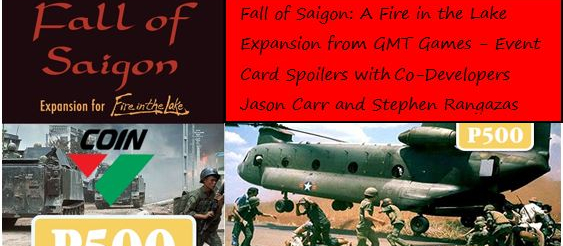My favorite COIN experience is Fire in Lake: Insurgency in Vietnam from GTM Games designed by Mark Herman and Volko Ruhnke. The Vietnam experience is thick in this one and the interplay among the factions is just glorious. We have played the game well over a dozen times and still enjoy every minute of it. In August 2019, GMT announced an expansion to the game in Fall of Saigon which focuses on the end of the war from 1973-1975. Three Fall of Saigon scenarios enable 1-4 players to extend play beyond Paris, beginning before 1968’s Tet, on the eve of the 1972 Easter Offensive, or from 1964 all the way to the end of the war. A standalone 2‑player Black April scenario focuses tightly on the post-Paris sparring between the NVA and ARVN, including the final massive battles, advances, and retreats.
Once the game was announced we reached out to the design and development team to see if we could do a series of Event Card Spoilers and Jason Carr agreed to provide those. We will be hosting 12 of these Event Card Spoiler posts over the next several months and appreciate the effort that both Jason Carr and Stephen Rangazas will be putting into these short write ups intended to share the history of the card as well as their play effects.
*Please keep in mind that the artwork and layout of these cards is not yet finalized (although they are getting close) and is only for playtest purposes at this point. Also, as this game is still in development, card details may still change prior to publication.
 #S11 Le Duan
#S11 Le Duan
Le Duan was the General Secretary of the Communist Party of Vietnam throughout the Second Indochina War. Originally from the South, Le Duan was a committed member of the Militant faction of the Politburo in Hanoi who advocated for an escalation of northern assistance to the insurgency in South Vietnam during the 1950’s. With chaos in South Vietnam following the overthrow of Ngo Dinh Diem, Le Duan’s militant strategy becomes official policy at the Ninth Plenum in late 1963.
By the beginning of 1964, Le Duan secured his place as the leader of North Vietnam. Over the course of 1964, Le Duan decided to commit NVA regulars to the South in an attempt to “go-for-broke” and win the war in the South before the United States could decisively intervene. Le Duan’s “go-for-broke” mentality would also lead to his further attempts to achieve a decisive victory during the Tet and Easter Offensives later in the war.
With the failure of the 1972 Easter Offensive to knock out the ARVN and the costs imposed by Operation Linebacker I and II, the debate re-opened in the Politburo over prioritizing reconstruction in the North or pursuing the war in the South. Le Duan remained committed to the latter. Le Duan favored another conventional general offensive against the South similar to the Easter Offensive once the Politburo was sure the United States would not re-intervene to save South Vietnam.
Throughout his time as leader of the North, Le Duan purged opposing views from the Politburo. He sidelined Ho Chi Minh and General Giap after 1963 due to their more moderate stance toward the war in the South. Given their enormous prestige from the 1945-1963 period, they could not be purged like other members of the Politburo and could still have significant influence over decision-making.
In Fall of Saigon, Le Duan’s continued rivalry with Giap can be exploited by the ARVN or US to flip an NVA Capability (for example, SA-2s or AAA or Shaded PT-76), or add 3 War Weariness, which is a new concept in Fall of Saigon. War Weariness is subtracted from the NVA Victory total starting after the Paris Accords, and can only be adjusted by Events. From the NVA side, Le Duan’s militant strategy grants immense flexibility by allowing 4 individual Limited Operations plus an Infiltrate. This could be used to march and attack multiple times, or to repeatedly train Armor (more on Armor in a future installment!).
NOTE: The North Vietnamese side of the war used to be fairly opaque and only given brief treatment in scholarship on the war. Readers interested in the North Vietnamese side of the war should check out Pierre Asselin’s recent book, Vietnam’s American War: A History, which synthesizes the recent scholarship into a short accessible book that is a nice complement to any general history of the war.

Thanks to the development team for their efforts in writing these up to share with our readers. As one of America’s more fascinating periods of history, the end of the Vietnam War definitely has an interesting story to tell and I am glad to see this expansion being made and look forward to playing again once it is released. We had the opportunity to play with Mark Herman and Dan Pancaldi during WBC last July and it was a blast. Here is a video summarizing our experience: https://theplayersaid.com/2019/09/01/wbc-look-at-fall-of-saigon-a-fire-in-the-lake-expansion-from-gmt-games/
We also posted an interview with co-designer Volko Ruhnke on the blog and you can read that at the following link: https://theplayersaid.com/2019/09/30/interview-with-volko-ruhnke-co-designer-of-fall-of-saigon-a-fire-in-the-lake-expansion-from-gmt-games/
Finally, if you are interested in Fall of Saigon: A Fire in the Lake Expansion, you can -pre order a copy from the P500 game page on the GMT Games website at the following link: https://www.gmtgames.com/p-832-fall-of-saigon-a-fire-in-the-lake-expansion.aspx
-Grant
